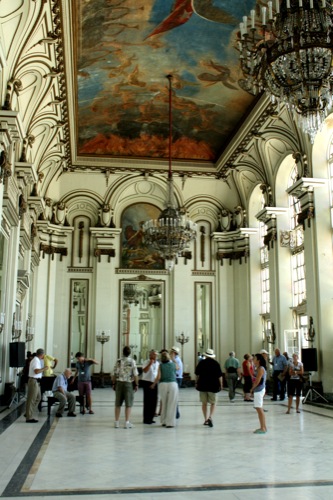
Interactive Experience
After several days in Havana, we traveled west to the town of Santa Maria, where our hosts had arranged for us to attend a children’s theater performance of “Romeo and Juliet” at the Santa Maria Art School and Cultural Center. Nobody in the group was prepared for how remarkable this experience would be.
The Santa Maria Art School and Cultural Center is set inside a beautiful classical building in the town square. The theatrical presentation took place on the second floor, where the children earnestly sang, danced and acted.
Several dozen children, all between the ages of 6 and 14 years old, made up this dance and theater troupe. Accompanied by their parents, technicians, musicians and directors, their ranks swelled to rival the size of the American audience. The director introduced the play as a “Cuban ‘Romeo and Juliet’” and advised us that it would be different than the story we knew.
The children wore traditional Cuban costumes and performed the 10-minute play in Spanish. It didn’t take a translator to understand what is happening: Although Romeo and Juliet are in love, their fathers are feuding with each other, thus inhibiting the budding romance. When the respective mothers find out about this, they quickly set their husbands straight, with a bit of slapstick violence. A wedding ensues, and there is a lot of dancing.
Before we knew it, the choreographed dancing evolved into an interactive fiesta. In minutes, the entire group of Americans joined the children on the dance floor, along with their parents and instructors.
After the dancing ended, our group members were eager to talk to their new friends, take pictures and hug before saying goodbye. In less than an hour, this group of children had chipped a brick out of the cultural and political wall that divides our two nations.
A Musical Breakthrough
Later in the trip, we visited Cienfuegos, a beautiful small city known as the “Pearl of the South.” Established by the French in 1819, this city reflects a refined colonial aesthetic in its layout and architecture, a welcome change from the Soviet-style block buildings found in many other parts of the country.
We walked up a pedestrian avenue to the Thomas Terry Theatre, an 1889 building, to hear a performance by the local chamber orchestra. Piling into the small fluorescent-lit room, nobody had high expectations for this experience.
The first note changed everything. Within seconds, the room was awash in a sea of beautiful sounds, with a richness of texture and depth of tone that belied the small size of the ensemble and the bare surroundings of the performance hall. The 10 musicians of the Orquestra de Camera Concierto Sur (Southern Chamber Concert Orchestra) are no amateurs but experts who could hold their own amongst the world’s best.
Our group sat in rapt attention as the musicians played classical masterpieces, American show tunes and Cuban “danzónes.” With the opening chords of the beautiful “Somewhere Over the Rainbow,” I saw tears welling in several people’s eyes.
After the concert, we had a short question-and-answer session with the musicians, who told us about their musical training and spoke frankly about the challenges of performing in Cuba. The humidity wreaks havoc on delicate wooden instruments, and it’s very difficult to get new violin strings. Most are imported from Europe at great expense.
Our group members bought all the CDs the group had for sale, and some music fans from Tempe, Arizona, began talks with the conductor to see about arranging for the orchestra to perform in the United States. In a remarkable feat of persistence, the Americans made it happen, bringing this Cuban orchestra to the States for a groundbreaking performance in Tempe a few months after our trip.











